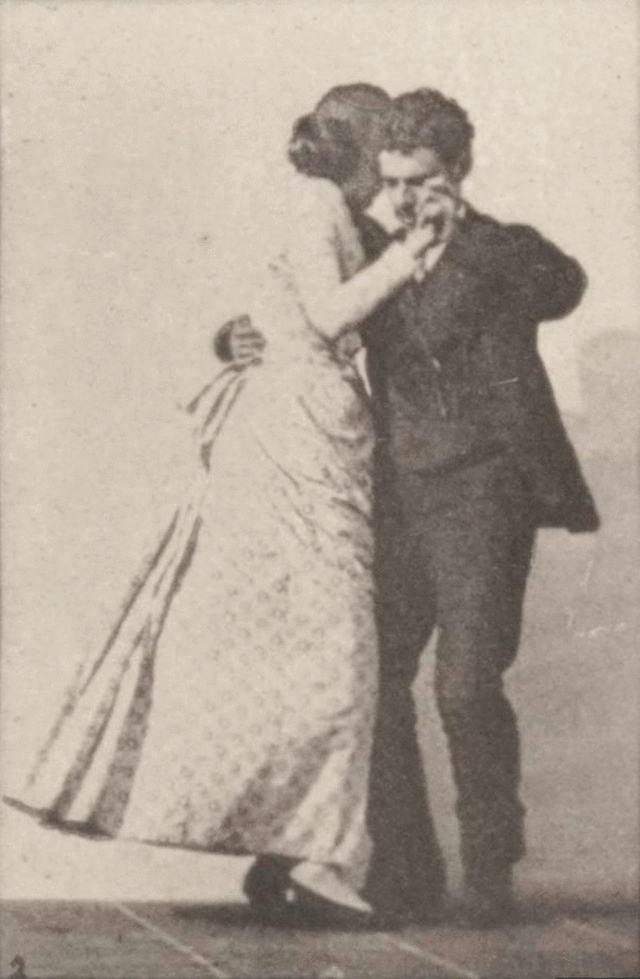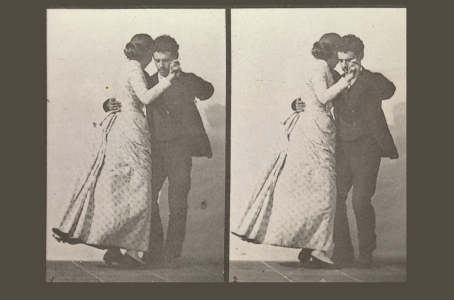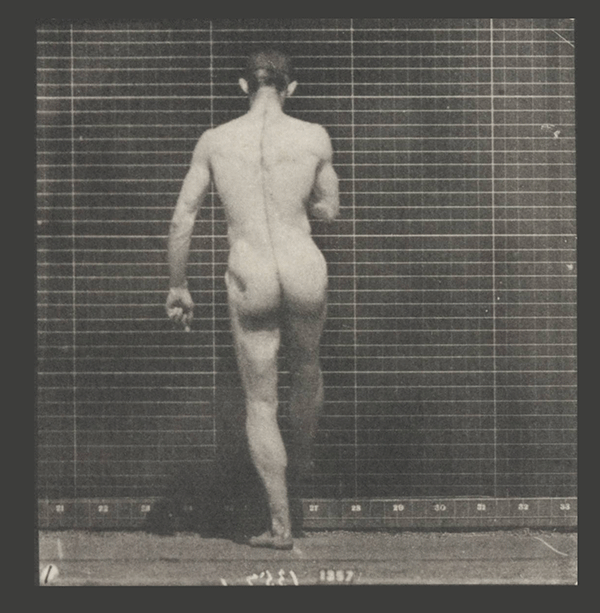

HOLOGRAMS from EADWEARD MUYBRIDGE'S
Studies of The Human Figure in Motion
Eadweard Muybridge is chiefly remembered for his extraordinary work with the photography of movement. He was the first person to prove that a horse, at full gallop, took all four of it's hooves off the ground at one point in it's stride.
Muybridge was given sponsorship by the University of Pennsylvania, where he undertook
his most famous project. In one year he took more than 20,000 photographs of men,
woman, children, animals and birds and in 1887 the photographs were published as
a monumental work of 781 folio-
What is less known about Muybridge’s photographs is that the have latent parallax: when a sequence of his photographs is presented as a short animation the motion parallax is perceived:
In this example, the observed three-
The stereoscopic parallax is seen
clearly when two frames of the sequence are removed and put together side-
Free-
The fact that the photographs have parallax information in them is a direct result
of the way in which the photographs were taken: Muybridge was working several years
before the invention of the cine-
A total of 20 holograms of selected Muybridge sequences were made as part of PhD thesis “Aspects of Spatial and Temporal Parallax in Multiplex Holograms’ at the Royal Collage of Art in 1994. Each of the holograms combines both the stereoscopic parallax and the motion parallax that is latent within the photographic sequences.
The "Arabesque" was the first hologram in the Muybridge series.
In the original Muybridge
plates, this is an austere image, vaguely reminiscent of Gray's anatomical drawings,
whilst the pose is redolent of Leonardo Da Vinci's famous drawing the ‘Vitruvian
Man’ (also called the ‘Canon of Proportion’), of a nude man framed in a circle and
square.
Because Muybridge shot each of his sequence against a grid of lines in the background, it is possible to see very accurately the degree of motion that the subject has undergone from one frame to the next. This proved very valuable in analysing the relationship of the stereoscopic parallax (generated by the different views from each of the cameras and governed by the distance between the cameras) to the temporal parallax (generated by the subject’s rotational motion from one photograph to the next) in the sequence.
Not a great deal has been written about temporal parallax (or motion parallax) in books about Stereoscopic Photography or Holography, however, N.A. Valyus in his book ‘Stereoscopy’ defines temporal parallax as:
"The displacement of any image point which occurs in a time corresponding to the visual inertia of the eye relative to the image of the moving fixation point".
Perhaps a more straightforward description would be: "how a one-
Temporal parallax might be described as "memory parallax" because whilst stereoscopic parallax is derived from a comparison of two views both seen at the same moment with two eyes, temporal parallax is perceived by a comparison with the view seen by the eyes at one moment in time, compared with an instant later.
In the "Arabesque" hologram, the fact that the figure is standing on one leg, anchored to the same spot throughout the sequence, means that this portion of the scene contains only stereoscopic parallax, caused by the lateral displacement of the cameras used to record the sequence.
In the sequence, the figure moves his right leg clockwise through 180 degrees This may be regarded, for the purpose of parallax analysis, as two progressions of 90 degrees each. What is fascinating is the very different way these two motions are interpreted by the brain.
If one examines frames 4 and 5 as a stereoscopic pair, one can see the hyper parallax distortion on the outstretched leg. In the first part of the rotation, although most of the other image points in the scene fuse together well, those image elements (the foot and leg) where to stereoscopic parallax has been added to the subject’s motion parallax, appear to go deep into the scene, away from us (so that the solid back wall looks like a net with the leg extending through and beyond it.
As the figure continues to rotate his leg through a further 90 degrees (clockwise), and the subject’s motion parallax again is combined with the stereoscopic parallax in our perception of the image:
If one examines frames 8 and 9 as a stereoscopic pair, one can see the hyper parallax
distortion on the outstretched leg. Resting one's gaze on the extended foot, and
comparing its position relative to the grid backdrop, one can discern that the limb
is stretched out towards the observer, like a tiny foot at the end of a insect-
Although the motion of the leg is constant, in a
The Muybridge sequences were made from left-
Understanding that a camera movement, a dolly or track shot laterally past the subject
has an effect on the percieved dimensionality of the subject is critical to adding
effective realism to the scene. Even in a simple shot of a person talking to camera
can be made much more compelling if there is a subtle tracking shot moving from the
left to the right past the subject (as opposed to the opposite, from the right to
the left); likewise a subject motion rotating clockwise to a camera (in a fixed position)
will provide more realism that an anti-
Temporal parallax in film,
video and television can be as engaging to the viewer as stereoscopic parallax (in
3-
The best example of
motion parallax used in a feature film was in The Matrix, in 1999 which introduced
(or rather re-
"Arabesque" (above) and other holograms were exhibited in a one-
Notes.
1. Stephen Herbert notes in his blog (9 March 2009) that Eadweard Muybridge was the first to invent ‘Bullet time’ the cinematic effect used in films such as ‘The Matrix’ (1999).
![]()
2. See also: ‘WHO INVENTED BULLET TIME’
3. See also: ‘A Brief History Of Bullet Time, Aka The Matrix Effect’



All frames from ‘Animal locomotion plate 197 male and female dancing waltz’ arranged to make a short looped animation.


The first and second image from ‘Animal locomotion plate 197 male and female dancing
waltz’ arranged side-


The first and second image from ‘Animal locomotion plate 197 male and female dancing
waltz’ arranged side-


Eadweard Muybridge 'Animal locomotion' plate 369, captioned "First ballet action"
Parallel
free-

The "Arabesque" hologram made from Eadweard Muybridge
'Animal locomotion' plate 369,
captioned "First ballet action"
The hologram captures both the motion (temporal) parallax
and the stereoscopic parallax in the sequence. See a video of the hologram:
One-


Bullet Time, (almost) 1884 “According to Wikipedia: [Bullet-
But not in this example, which certainly has dimensionality.
My
crude animation of Animal Locomotion Plate 527, Spanking a child, will I hope demonstrate
that the technique generally known as "bullet-
Mr. Muybridge, once in the studio of Mr. Perry, watched with interest the artist
endeavoring to outline the picture of a California coach and four. He had Mr Muybridge's
pictures as a guide. But these were broadside views, and he wanted a quartering view.
Mr Muybridge hastened back to Palo Alto, arranged five cameras in a semicircle and
concentrating upon one point, galloped a horse over the point where the electric
current was completed, and produced a perfect picture of a horse at fullest speed,
as seen from five different points of view, all at the same instant of time and while,
of course, the horse was in one and the same position. Now, an artist with these
pictures as guiides can draw a horse in any position desired.” -


Image 4 & 5 from plate 369, arranged side-


Image 5 & 4 from plate 369, arranged side-


Image 8 & 9 from plate 369, arranged side-


Image 9 & 8 from plate 369, arranged side-


All the frames of 'Animal locomotion' plate 369, "First ballet action" arranged
together to form a short animation where the motion parallax can be clearly seen
(but there is no stereoscopic parallax) the sense of the 3-
This clip from ‘The Matrix’ shows the camera proceeding in an anti-
In order to avoid subject motion moving counter to the direction of orthoscopic parallax, most examples of ‘Bullet time’ are of a ‘frozen moment’ (aka ‘time slice’) where a set of cameras are all triggered to expose at the same instant, so as to freeze all subject motion.